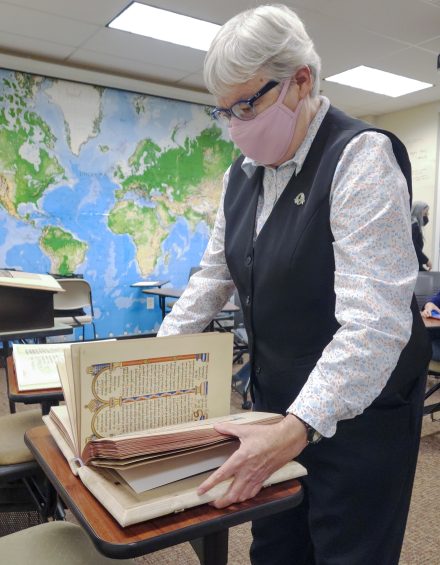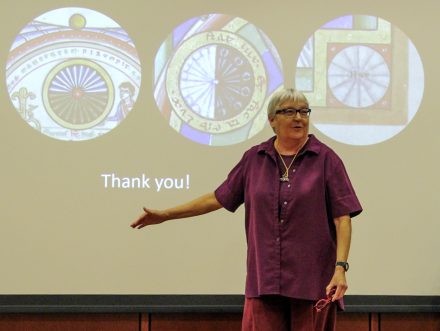Capped by art historian Elizabeth C. Teviotdale’s Art History Speaker Series lecture, Elon students examined rare facsimiles of premodern art and their present-day relevance
It’s one thing to study premodern art in books or museums — secured behind ropes or glass — but quite another to hold it in your hands.
A series of guest lecturers recently gave students in Elon’s Art History program the opportunity to pore over and page through rare, finely detailed facsimiles of medieval European manuscripts.

Those objects included a facsimile of the Stammheim Missal, an elaborately painted and illuminated 12th-century manuscript created by the Benedictine monastery of St. Michael’s Church in Hildesheim, Germany. Elizabeth C. Teviotdale, an art historian who researched and wrote the missal facsimile’s official commentary, met with students and lectured about the missal in an Art History Speaker Series event on Wed., Oct. 19, in LaRose Theater.
Delaney Guidi ’26 was among those who held and examined the facsimiles in the ARH 2110 Art History of the Medieval and Premodern World course taught by Assistant Professor Miranda Lee Elston.
“This is a prime example of a way that space, in the case on the page, can be reused,” Guidi said. “We are repurposing art so that it can fit our needs today. We’ve also talked a lot about how to make art accessible and ethical. Very few people have access to the original manuscripts, even art historians, so these facsimiles are a way to make these more accessible.”
Teviotdale met with Elston’s class to discuss decades of researching original manuscripts, and the Stammheim Missal’s purpose beyond instructions for Catholic mass as “almost an object of propaganda” in the campaign to canonize St. Michael’s founder Bishop Bernward of Hildesheim. Teviotdale is a leading scholar of medieval art and music, is an associate of the UCLA Center of Medieval and Renaissance Studies and was assistant director of the Medieval Institute at Western Michigan University from 2002 to 2020. She and Professor of Art History Evan Gatti also spoke about the audience for facsimiles — often wealthy Europeans investing in limited edition prints and scholars seeking access to rare manuscripts.

“Very few people are allowed to study the original manuscripts, and those barriers to access exist for good reason: to preserve them,” Teviotdale said. “But nothing replaces hands-on study of the original documents. You can only understand if there are image reproduction problems or quirks in digital or printed facsimiles because you’ve had hands-on experience with original manuscripts.”
The original Stammheim Missal manuscript is owned by the J. Paul Getty Museum of Los Angeles, where Teviotdale was an associate curator. Her copy of the Stammheim Missal facsimile is on loan to the Art History Program through this academic year. Along with other examples of European facsimiles, that facsimile is on exhibition this academic year in “Medieval Manuscripts and Modern Facsimiles” in Lindner Hall.
“This art isn’t just in the past,” said Gatti, who was mentored by Teviotdale and curated the Lindner exhibition. “It continues to exist into the present and it shapes how we know the present. These works help us see that we haven’t answered all of the questions, we haven’t explored all the possibilities, and they haven’t stopped shaping how we know ourselves, where we live and where others live.”
Teviotdale’s Art History Speaker Series lecture covered her research of the missal and how Benedictine artists’ detailed presentation of time within the manuscript’s illustrations converse with neighboring illustrations showing their belief that Christian salvation was inherent in the Biblical creation.
Jacob Van Buren ’23, an art history major, helped prepare the Lindner Hall display and attended Teviotdale’s lecture. Working with Teviotdale and Gatti to prepare the exhibit gave him a new appreciation of the curious and modern choices some publishers make in the reproduction process.
“While designed to faithfully reproduce the likenesses of manuscripts like the Stammheim Missal, it was interesting to hear more about where they deviate from their working material,” Van Buren said. “For example, one of the facsimiles in the exhibition is bound in parchment whereas the pages themselves are on a more modern stock. It was one of those odd details which showcased the very human process behind these documents.”

Giovanni Scorcioni, a co-founder of Facsimile Finder, which is a leading source of facsimiles, spoke to Elston’s class about how facsimiles are produced earlier in the week. Elston also led examination of the modern acquisition of original manuscripts by tycoons in the 19th and 20th centuries.
“The larger theme this week is really thinking about the objects outside of their original context, how they have been changed or adapted, and to learn about why we would do this,” Elston said. “Bringing in these outside speakers to share their passions tend to be great classes because they are so excited about what they do, and students feed off that energy. Our students were really excited about getting to handle these manuscripts, to flip through these pages, and engage with them. That elicited even more conversations about how facsimiles are made” and how “the current moment informs our study of the past.”
Jackson LaRose ’25, a double major in international business and religious studies, said taking the art history course alongside religious studies courses has deepened his understanding of issues across disciplines.
“They’ve been elevating each other in really interesting ways that might not happen if I were taking them one at a time,” LaRose said. “I’m thinking about these facsimiles regarding how different people have very different criteria for what they deem to be a ‘complete facsimile’ versus a partial one, and how some are created much more rigorously than others. It’s interesting to look at the publishing choices made.”
For Guidi, the week’s experiences brought to life her understanding of world history, how it shapes the present and how art is used to transmit messages across time.
“This course has done more for me about understanding the interrelationships and global relationships between nations better than any world history class I’ve ever taken,” Guidi said. “You look at this painting, and you can tell when it was made” based on objects it depicts, like pineapples after South American colonization, or the colors and materials used. “You’re pulling in information from history and it’s very fascinating to see it tangibly.”


